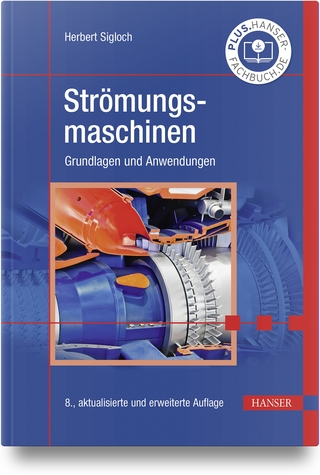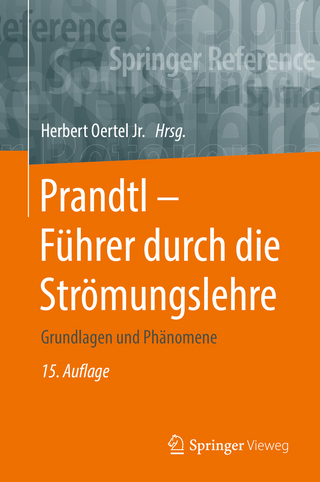
Munson, Young and Okiishi's Fundamentals of Fluid Mechanics, International Adaptation
John Wiley & Sons Inc (Verlag)
978-1-119-70326-6 (ISBN)
1 INTRODUCTION
Learning Objectives
1.1 Characteristics of Fluids
1.2 Dimensions, Dimensional Homogeneity, and Units
1.3 Analysis of Fluid Behavior
1.4 Measures of Fluid Mass and Weight
1.5 Ideal Gas Law
1.6 Viscosity
1.7 Compressibility of Fluids
1.8 Vapor Pressure
1.9 Surface Tension
1.10 A Brief Look Back in History
CHAPTER SUMMARY AND STUDY GUIDE
KEY EQUATIONS
REFERENCES
PROBLEMS
2 FLUID STATICS
Learning Objectives
2.1 Pressure at a Point
2.2 Basic Equation for Pressure Field
2.3 Pressure Variation in a Fluid at Rest
2.4 Standard Atmosphere
2.5 Measurement of Pressure
2.6 Manometry
2.7 Mechanical and Electronic Pressure Measuring Devices
2.8 Hydrostatic Force on a Plane Surface and Pressure Diagram
2.9 Hydrostatic Force on a Curved Surface
2.10 Buoyancy, Flotation, and Stability
2.11 Pressure Variation in a Fluid with Rigid Body Motion
2.12 Equilibrium of moving fluids (Special case of Fluid Statics
CHAPTER SUMMARY AND STUDY GUIDE
KEY EQUATIONS
REFERENCES
PROBLEMS
3 FLUID KINEMATICS
Learning Objectives
3.1 The Velocity Field
3.2 The Acceleration Field
3.3 Control Volume and System Representations
3.4 The Reynolds Transport Theorem
CHAPTER SUMMARY AND STUDY GUIDE
KEY EQUATIONS
REFERENCES
PROBLEMS
4 ELEMENTARY FLUID DYNAMICS--THE BERNOULLI EQUATION
Learning Objectives
4.1 Newton’s Second Law
4.2 F = ma along a Streamline
4.3 F = ma Normal to a Streamline
4.4 Physical Interpretations and Alternate Forms of the Bernoulli Equation
4.5 Static, Stagnation, Dynamic, and Total Pressure
4.6 Applications of Bernoulli Equation
4.7 The Energy Line and the Hydraulic Grade Line
4.8 Restrictions on Use of the Bernoulli Equation
CHAPTER SUMMARY AND STUDY GUIDE
KEY EQUATIONS
REFERENCES
PROBLEMS
5 FINITE CONTROL VOLUME ANALYSIS
Learning Objectives
5.1 Conservation of Mass--The Continuity Equation
5.2 Newton’s Second Law--The Linear Momentum and Moment of Momentum Equations
5.3 First Law of Thermodynamics--The Energy Equation
CHAPTER SUMMARY AND STUDY GUIDE
KEY EQUATIONS
REFERENCES
PROBLEMS
6 DIFFERENTIAL ANALYSIS OF FLUID FLOW
Learning Objectives
6.1 Fluid Element Kinematics
6.2 Conservation of Mass
6.3 The Linear Momentum Equation
6.4 Inviscid Flow
6.5 Some Basic, Plane Potential Flows
6.6 Superposition of Basic, Plane Potential Flows
6.7 Other Aspects of Potential Flow
6.8 Viscous Flow
6.9 Some Simple Solutions for Laminar, Viscous, Incompressible Flows
6.10 Other Aspects of Differential Analysis
CHAPTER SUMMARY AND STUDY GUIDE
KEY EQUATIONS
REFERENCES
PROBLEMS
7. DIMENSIONAL ANALYSIS AND MODEL SIMILITUDE
Learning Objectives
7.1 The Need for Dimensional Analysis
7.2 Buckingham Pi Theorem
7.3 Determination of Pi Terms
7.4 Some Directions about Dimensional Analysis
7.5 Determination of Pi Terms by Inspection
7.6 Common Dimensionless Groups in Fluid Mechanics
7.7 Correlation of Experimental Data
7.8 Modeling and Similitude
7.9 Typical Model Studies
CHAPTER SUMMARY AND STUDY GUIDE
KEY EQUATIONS
REFERENCES
PROBLEMS
8 VISCOUS FLOW IN PIPES
Learning Objectives
8.1 General Characteristics of Pipe Flow
8.2 Fully Developed Laminar Flow
8.3 Fully Developed Turbulent Flow
8.4 Pipe Flow Losses via Dimensional Analysis
8.5 Pipe Flow Examples
8.6 Pipe Flowrate Measurement
CHAPTER SUMMARY AND STUDY GUIDE
KEY EQUATIONS
REFERENCES
PROBLEMS
9 FLOW OVER IMMERSED BODIES
Learning Objectives
9.1 General External Flow Characteristics
9.2 Drag
9.3 Lift
9.4 Boundary Layer Characteristics
CHAPTER SUMMARY AND STUDY GUIDE
KEY EQUATIONS
REFERENCES
PROBLEMS
10 OPEN CHANNEL FLOW
Learning Objectives
10.1 General Characteristics of Open Channel Flow
10.2 Surface Waves
10.3 Energy Considerations
10.4 Uniform Flow
10.5 Most Efficient Channel Section
10.6 Gradually Varied Flow
10.7 Rapidly Varied Flow
CHAPTER SUMMARY AND STUDY GUIDE
KEY EQUATIONS
REFERENCES
PROBLEMS
11 COMPRESSIBLE FLOW
Learning Objectives
11.1 Ideal Gas Thermodynamics
11.2 Stagnation Properties
11.3 Mach Number and Speed of Sound
11.4 Compressible Flow Regimes
11.5 Shock Waves
11.6 Isentropic Flow
11.7 One Dimensional Flow in a Variable Area Duct
11.8 Constant Area Duct Flow with Friction
11.9 Frictionless Flow in a Constant Area Duct with Heating or Cooling
11.10 Analogy Between Compressible and Open Channel Flows
11.11 Two Dimensional Supersonic Flow
11.12 Effects of Compressibility in External Flow
CHAPTER SUMMARY AND STUDY GUIDE
KEY EQUATIONS
REFERENCES
PROBLEMS
12 TURBOMACHINES
Learning Objectives
12.1 Introduction
12.2 Basic Energy Considerations
12.3 Angular Momentum Considerations
12.4 The Centrifugal Pump
12.5 Axial Flow and Mixed Flow Pumps
12.6 Dimensionless Parameters and Similarity Laws
12.7 Turbines
12.8 Fans
12.9 Compressible Flow Turbomachines
CHAPTER SUMMARY AND STUDY GUIDE
KEY EQUATIONS
REFERENCES
PROBLEMS
APPENDIX A Computational Fluid Dynamics
APPENDIX B Physical Properties of Fluids
APPENDIX C Properties of the U.S. Standard Atmosphere
APPENDIX D Compressible Flow Functions for an Ideal Gas with k = 1.4
APPENDIX E Comprehensive Table of Conversion Factors
INDEX
| Erscheinungsdatum | 29.06.2021 |
|---|---|
| Verlagsort | New York |
| Sprache | englisch |
| Maße | 10 x 10 mm |
| Gewicht | 454 g |
| Themenwelt | Naturwissenschaften ► Physik / Astronomie ► Strömungsmechanik |
| Technik ► Maschinenbau | |
| ISBN-10 | 1-119-70326-3 / 1119703263 |
| ISBN-13 | 978-1-119-70326-6 / 9781119703266 |
| Zustand | Neuware |
| Informationen gemäß Produktsicherheitsverordnung (GPSR) | |
| Haben Sie eine Frage zum Produkt? |
aus dem Bereich


